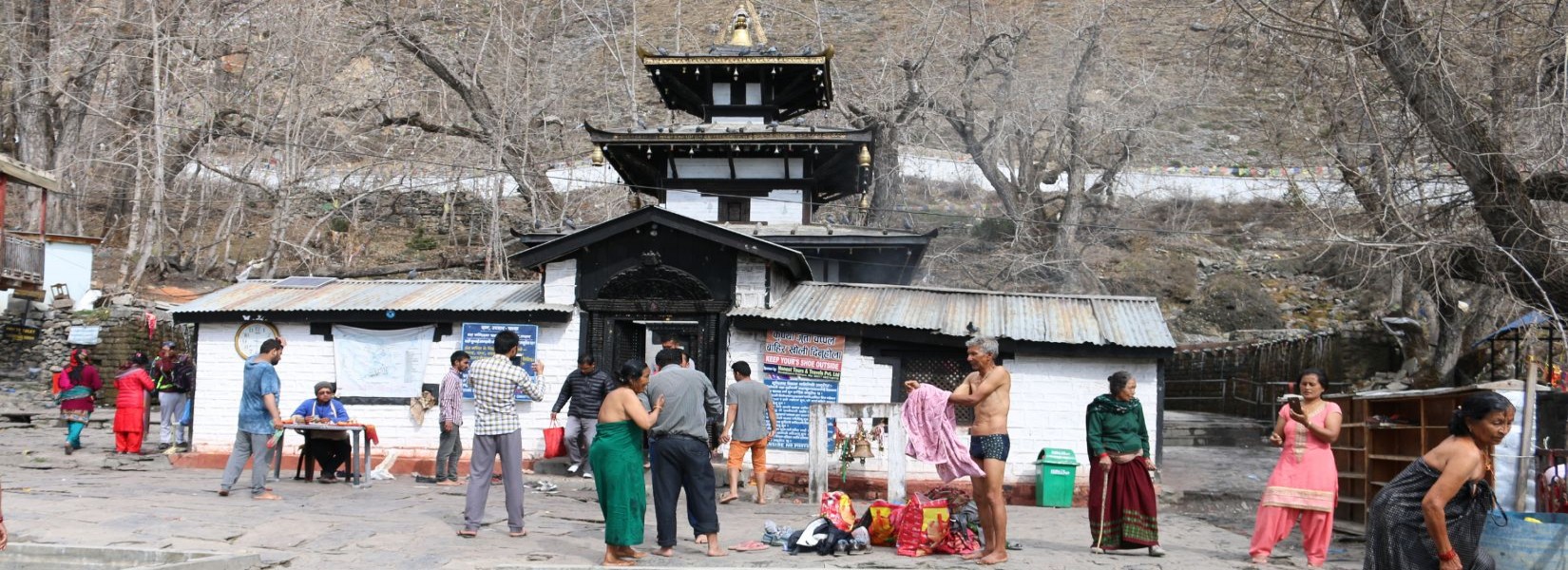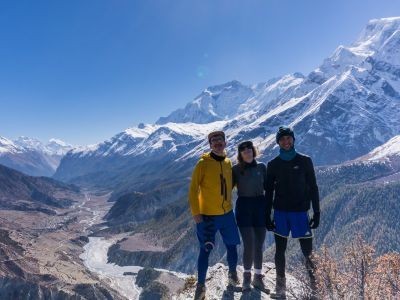Spiritual Muktinath Temple, nestled in Nepal's Mustang district at an altitude of about 3,710 meters, is a revered site for both Hindus and Buddhists. Known by different names, Hindus call it Muktinath (Temple of Liberation), while Buddhists refer to it as Chumig Gyatsa (Hundred Waters). Beyond its religious importance, the temple offers awe-inspiring views of the Dhaulagiri and Nilgiri mountain ranges. This article provides an in-depth exploration of the history, legends, major attractions, and pilgrimage journey to Muktinath Temple.
Table of Contents
The Essence of the word Muktinath
The name "Muktinath" holds profound spiritual meaning, derived from two Sanskrit words: "Mukti" meaning liberation or salvation, and "Nath" meaning lord or protector. Together, Muktinath signifies the "Lord of Liberation." For Hindus, it represents a sacred site where one can attain Moksha (freedom from the cycle of birth and rebirth) through devotion and ritual purification.
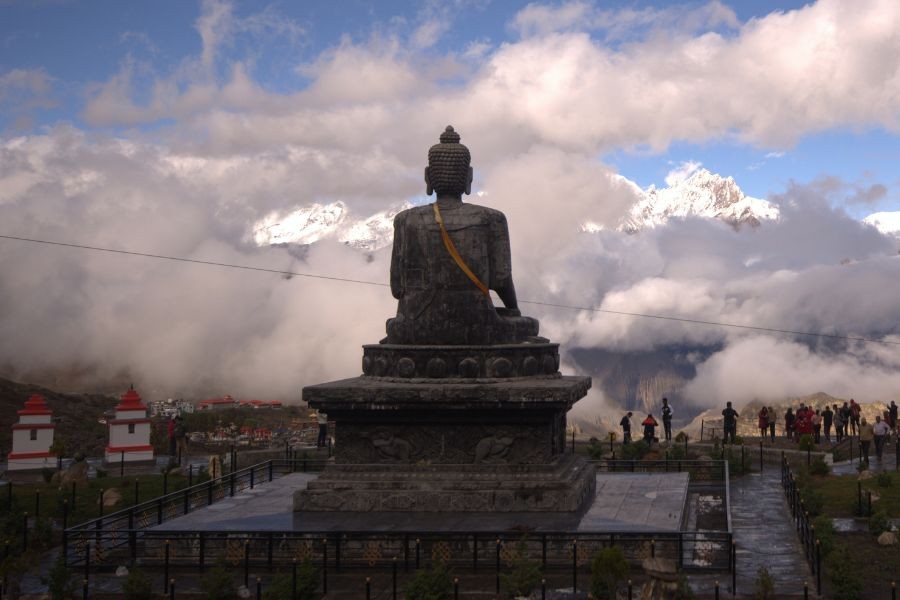
For Buddhists, the temple is revered as a place of spiritual awakening and enlightenment, and it is associated with Guru Rinpoche (Padmasambhava). This dual religious importance makes Muktinath a symbol of harmony and a destination for those seeking inner peace and salvation.
History of Muktinath Temple
The origins of the Muktinath Temple date back to the 1st century AD. Its significance is deeply rooted in Hindu and Buddhist traditions, with writings over centuries enhancing its sacred reputation. The renowned philosopher Adi Shankaracharya is believed to have contributed to its establishment as a pilgrimage site. Over time, devotees and rulers have preserved and expanded its prominence.
Location of Muktinath Temple
Muktinath Temple is situated in the Mustang District of Nepal, at an altitude of approximately 3,710 meters (12,172 feet), near the base of the Thorong La Pass (28°49′45″N 83°53′21″E). It lies within the Annapurna Conservation Area and is located along the famous Annapurna Circuit trekking route.
From Jomsom, the temple is approximately 20 kilometres (12 miles) away, accessible by a 1.5 to 2-hour drive or a 6 to 8-hour trek, depending on the pace and route.
Who Built the Muktinath Temple? Mythologies Behind It
A question worth asking is, who constructed the Muktinath Temple? The Muktinath Temple's construction reflects a blend of Hindu and Buddhist influences. According to legend, Adi Shankaracharya played a key role in elevating its status as a sacred pilgrimage site.
Its development shows some influence of Hinduism and Buddhism from the 8th century AD into present times.
It is also believed that the renowned philosopher, Adi Shankaracharya, visited and contributed to establishing the Muktinath Temple as an important place of pilgrimage.
The Muktinath Temple, also known as the Mustang Muktinath Temple, holds great significance in many cultural stories.
Hindu Myths
The temple is considered one of the eight Svayam Vyakta Kshetras (self-manifested shrines) of Lord Vishnu and one of the 108 Divya Desams. Hinduism views this place as the house of Lord Vishnu, who came here to take away a curse made by the sage Vrinda. This is a legend that Lord Vishnu cursed to happen because of his role in conjunction with Lord Shiva during his fight with demon king Jalandhar.
The intervention of Lord Vishnu changed demon king Jalandhar into a Shaligram, a petrified image, at Muktinath. Devotees make offerings with Tulsi leaves in the temple, signifying the marriage of Vishnu and Vrinda, The spiritual significance of Muktinath Temple attracts Hindu pilgrims from around the world.
A legend says Lord Vishnu took refuge here to rid himself of a curse from the sage Vrinda. The petrified image of Lord Vishnu, known as Shaligram, is a central feature of worship at the temple.
Another myth links Muktinath to Sati’s story. Her face is believed to have fallen at Muktinath, making it one of the Shakti Peethas. According to Swasthani Brata, as Shiva conveyed her body, parts fell behind and they created Shakti Peeths. It is believed that Sati's face fell at Muktinath and that mainly accounts for the sacredness of the temple.
Buddhist Myths
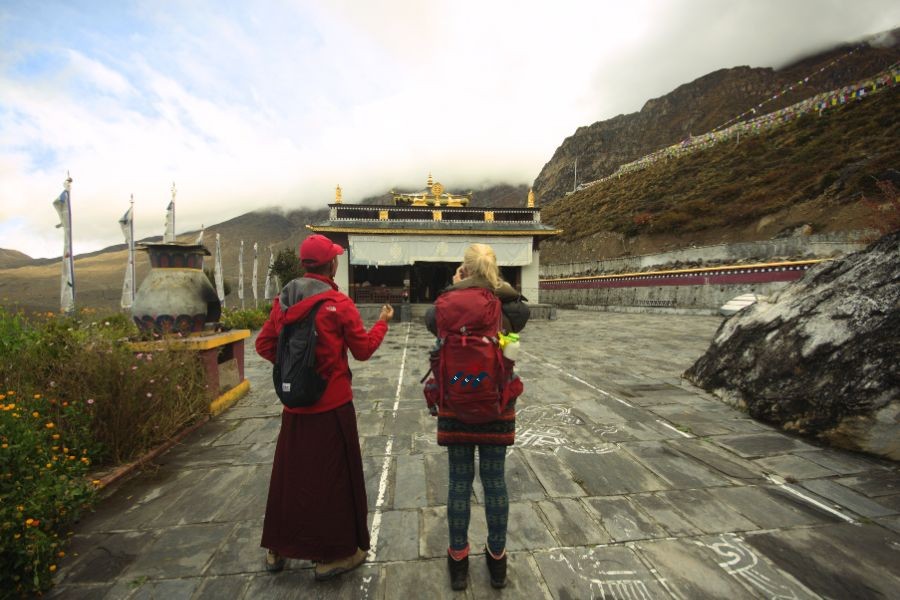
Another major legend linked to Muktinath comes from Buddhism: it is said that Guru Rinpoche, the founder of Tibetan Buddhism, meditated here in the 12th century and obtained spiritual enlightenment.
In essence, the Muktinath Temple is not only a profound symbol of architectural and spiritual heritage but also a remarkable representation of harmony between Hindu and Buddhist traditions, enriched by timeless legends and mythologies.
Major Attractions of Muktinath Temple
Muktidhara (108 Water Spouts)
The temple features 108 sacred water spouts, known as Muktidhara, arranged in a semi-circular formation. Pilgrims bathe in the icy water, which is believed to purify them of sins. The number 108 holds great spiritual significance in Hinduism and Buddhism, symbolizing cosmic completeness and the cleansing of 108 defilements of the mind.
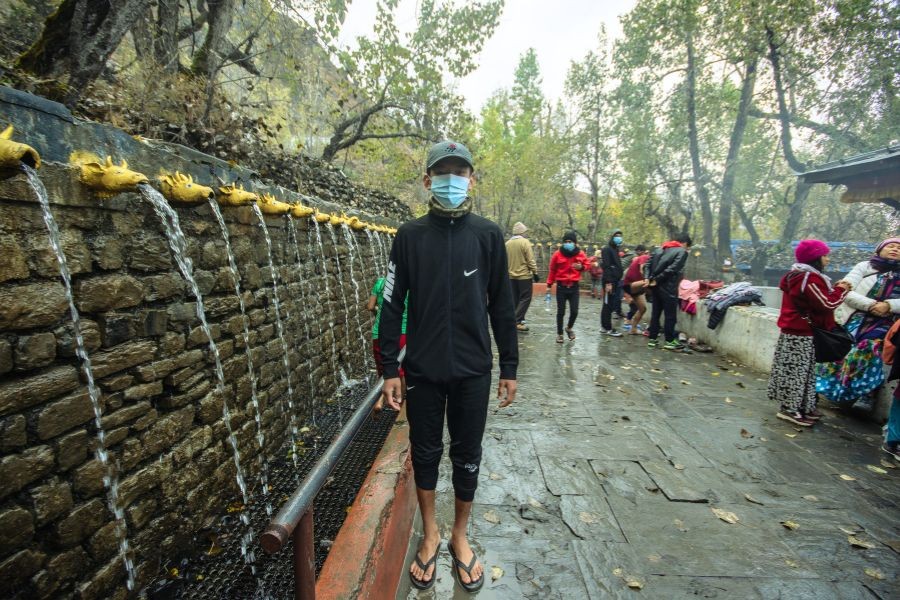
The 108 water spouts at Muktinath are deeply rooted in spiritual myths and beliefs in both Hinduism and Buddhism. The 108 water spouts represent purity and are used by pilgrims for ritual purification. Many bathe in the holy water to readjust their religious journey.
The fulfilment of the above purposes is greatly anchored in Hinduism and Buddhism, supported by divine myths and their importance in religious life.
These spouts are believed to have sacred properties, and their number, 108, holds great symbolic importance in these religions.
In Hinduism, 108 represents cosmic completeness, as it is associated with the sacred mantra "Om" and the number of beads on a mala used in meditation. Pilgrims believe that walking under each water spout and letting the icy water flow over their bodies purifies them of sins, granting liberation (moksha) and spiritual renewal. The water is said to originate from the Kali Gandaki River, revered as a manifestation of Lord Vishnu.
In Buddhism, the 108 spouts symbolize the cleansing of 108 defilements of the mind, a significant step toward enlightenment. It is also believed that Guru Rinpoche (Padmasambhava), who spread Tibetan Buddhism, meditated near this site and blessed the water, further adding to its sanctity.
The ritual bathing at the Muktidhara is a central act of devotion, combining the spiritual essence of nature, mythology, and the timeless quest for liberation and inner peace.
Millions of devotees from around the world visit Muktinath to attain spiritual fulfilment.
Jwala Mai Temple
Located below the Muktinath Temple, the Jwala Mai Temple houses three eternal flames fueled by natural gas. This houses water from a rock and small natural gas chimneys behind an old curtain, through which eternal flames proceed.
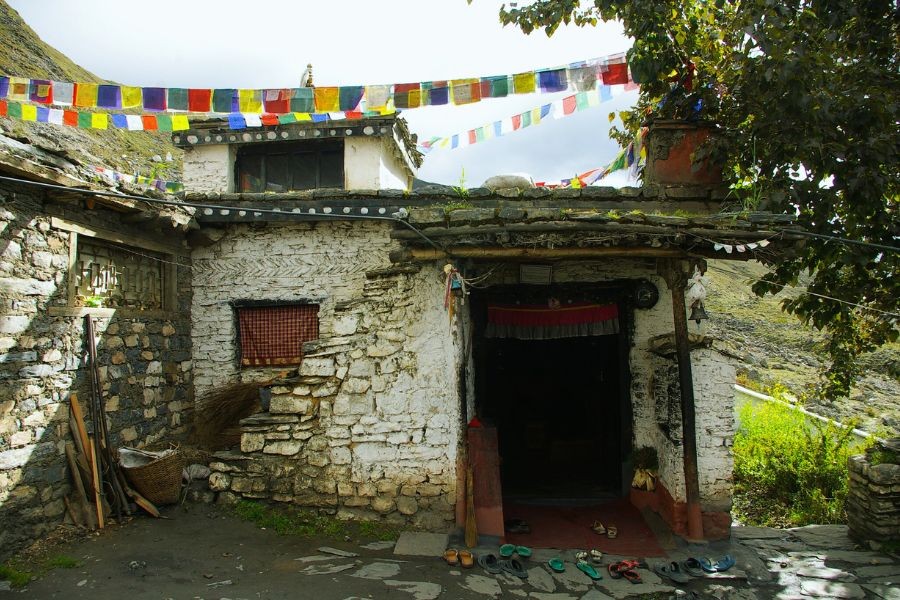
The Jwala Mai Temple contains a spring made up of three eternal flames: "Holy Flame from Soil," "Holy Flame from Rock," and "Holy Flame from Water," fed by natural gas, two of which are said to burn eternally.
The Hindu religion explains this as the first fire he lighted was igniting water as a sacred offering. These flames are revered by Hindus and Buddhists.
Muktinath Kunda
Adjacent to the temple are two sacred ponds, believed to grant salvation (Mukti) to those who bathe in them. Pilgrims believe this ritual releases them from the cycle of birth and death.
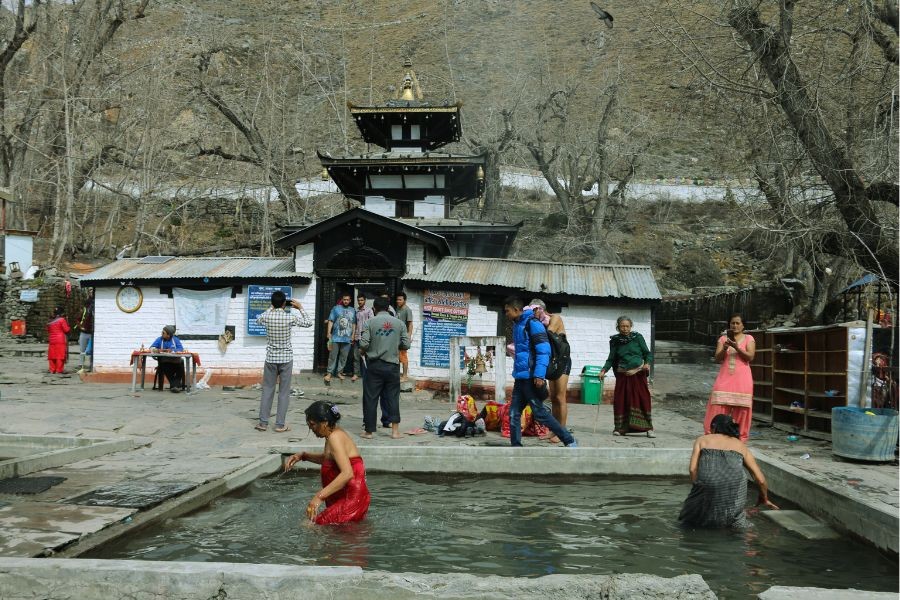
Shaligram Fossils
The nearby Kali Gandaki River is rich in Shaligram fossils, considered sacred manifestations of Lord Vishnu. Pilgrims often collect or purchase these fossils as spiritual souvenirs.
The River Kali Gandaki, where fossils from the Jurassic period can be collected, is another pilgrimage destination. The villagers also sell these fossils. If discovered, Shaligram, a black stone fossil, is revered and preserved in the home's Pooja (prayer) room.

It is thought to represent Lord Vishnu. Known by the Puranic names Krishnagandaki (Black Gandaki) and Chakranadi, and revered as one of the most sacred rivers, Krishnagandaki is made up of seven Gandaki rivers that are said to have arisen from Lord Vishnu's cheek (Gandasthal).
Natural Beauty
The Himalayas and other magnificent landscapes envelop Muktinath. The area is serene, offering breathtaking views of towering mountain peaks, rivers, and verdant valleys. There are snow-capped mountains all around the shrine.
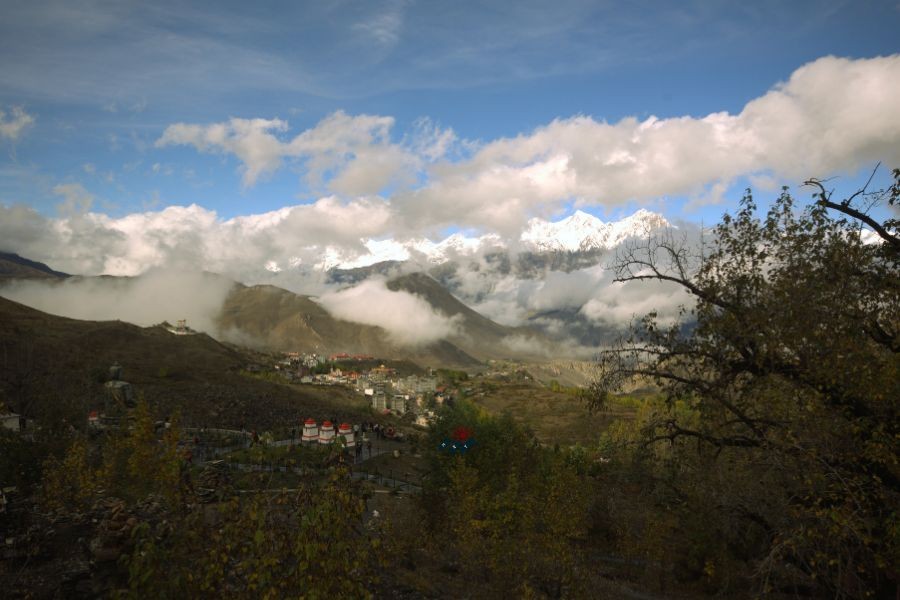
Spiritual Significance of Muktinath Temple
For Hindus
Moksha (Mukti/ Liberation): Muktinath is believed to help devotees achieve Moksha by purifying their souls through prayers, rituals, and bathing in the holy waters. Vishnu’s Role: As one of the 108 Divya Desams, the temple symbolizes Lord Vishnu’s grace in granting liberation.
Tirtha Yatra: Visiting Muktinath is considered a crucial pilgrimage to atone for sins and gain spiritual merit.
For Buddhists
Muktinath is revered as a meditation site of Guru Rinpoche, making it a significant destination for Tibetan Buddhists seeking spiritual enlightenment.
How to Reach Muktinath Temple
From Kathmandu
By Air: Fly from Kathmandu to Pokhara (25-30 minutes), then take a flight from Pokhara to Jomsom (20 minutes). From Jomsom, travel by jeep or bus (1.5 to 2 hours) or trek to Muktinath (5-6 hours).
By Road: Drive from Kathmandu to Pokhara (6-7 hours), then continue by jeep or bus to Jomsom (8-10 hours), followed by a jeep ride or trek to Muktinath.
From Pokhara
By Air: Take a flight to Jomsom, followed by a jeep ride to Muktinath.
By Road: Drive to Jomsom and proceed to Muktinath by jeep or trek.
Note: Weather conditions, especially during winter, may impact travel schedules. Planning is essential.
Jomsom-Muktinath Trek
The Jomsom-Muktinath trek is one of the most popular routes in the Annapurna region, combining nature, culture, and spirituality. The trail passes through picturesque valleys, high-altitude landscapes, and traditional villages inhabited by Thakalis, Gurungs, and Magars.
Bringing it All Together
The Muktinath Temple is not just a sacred pilgrimage site but also a profound symbol of harmony between Hindu and Buddhist traditions. Its spiritual significance, combined with the natural beauty of the Mustang region, makes it a must-visit destination for anyone seeking peace, enlightenment, and connection with the divine. Whether through the Jomsom-Muktinath trek or a direct journey, visiting this revered temple is an unforgettable experience that enriches the soul. If you want to explore Muktinath Temple, we invite you to join the Annapurna Circuit Trek.
